How To Repair A/c Insulation Hose
Weathering, UV rays and/or bad installation can compromise insulation on an AC unit. It's a good practice to inspect it every year and replace as needed making sure it's always doing its job.
Over time insulation on exterior HVAC lines can degrade from weathering, UV rays and poor installation causing a loss of effectiveness. When insulation loses its ability to insulate, energy is lost and the equipment must work harder to maintain the desired indoor comfort level.
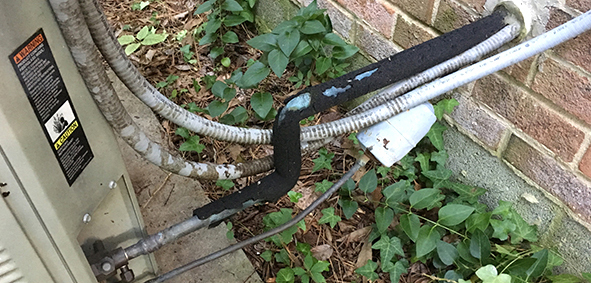
Insulation benefits and recommended type for AC:
In refrigeration and air-conditioning applications, insulation needs to be able to protect against condensation. Moisture control is critical to thermal efficiency. If moisture intrudes the insulating material surrounding cold-water piping, thermal efficiency is lost. Foam insulation, unlike fiberglass, is a closed-cell structure that acts as a built-in vapor retarder (jacket) preventing moisture intrusion. Closed-cell elastomeric insulation products like AP ArmaFlex® prevent condensation, moisture intrusion and loss of thermal efficiency. Its design provides excellent resistance to water vapor transmission and provides long-term durability without needing a vapor jacket. However, while AP ArmaFlex doesn't need a jacket to prevent moisture ingress, without any protection, the insulation will breakdown over time and will need regular maintenance.
Replacing insulation steps and tips:
-
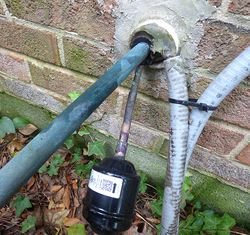 Identify the correct AC line to insulate. A typical residential AC unit has two copper lines that both exit the building exterior and run to the outside condenser unit. Only one of these copper pipes, the cold line, should be insulated. This is called the "suction" pipe and is typically the larger of the two pipes. There is no need to insulate the smaller, warmer copper pipe, often called the liquid line, because not insulating this line allows it to shed heat which is exactly what you are trying to do with an AC system.
Identify the correct AC line to insulate. A typical residential AC unit has two copper lines that both exit the building exterior and run to the outside condenser unit. Only one of these copper pipes, the cold line, should be insulated. This is called the "suction" pipe and is typically the larger of the two pipes. There is no need to insulate the smaller, warmer copper pipe, often called the liquid line, because not insulating this line allows it to shed heat which is exactly what you are trying to do with an AC system.
- Now measure the length and outer diameter of the copper pipe and the thickness of the old existing insulation. If no insulation is present for measuring thickness, look up the R-values recommended for your area or the manufacturer's suggestions.
- Once you have all the measurements, purchase insulation with the proper internal diameter to fit the pipe. You may also want to purchase insulation tape for wrapping pipe ends and any service valves.
-
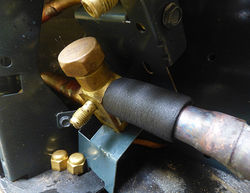 When you have all the supplies, turn off the AC and remove the old insulation. Wait for the suction line temperature to increase to the point where condensation does not reappear after it is wiped off. Clean any dirt off the pipe using an appropriate solvent such as denatured alcohol. After the pipe is clean and dry, wrap a few winds of insulation tape on the tubing where it exits the house and wrap any service valves on the condenser end of the tubing. Make sure insulation tape is squeezed tight around service values and firmly pressed against the exterior wall.
When you have all the supplies, turn off the AC and remove the old insulation. Wait for the suction line temperature to increase to the point where condensation does not reappear after it is wiped off. Clean any dirt off the pipe using an appropriate solvent such as denatured alcohol. After the pipe is clean and dry, wrap a few winds of insulation tape on the tubing where it exits the house and wrap any service valves on the condenser end of the tubing. Make sure insulation tape is squeezed tight around service values and firmly pressed against the exterior wall.
-
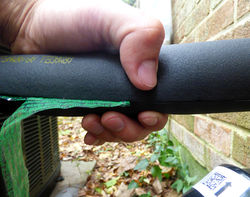 Now you are all set to install the new foam pipe insulation. Start by measuring the length of the AC line and cut the insulation end at least ½" longer to compensate for contraction and expansion temperature flux. Then slip the foam tube over the copper piping, overlapping the insulation tape. If using self-seal insulation, remove the adhesive liner and align the edges while pressing the seam together as you go. Remember to work cautiously with the adhesive because once the adhesive ends touch, you can't get them apart again.
Now you are all set to install the new foam pipe insulation. Start by measuring the length of the AC line and cut the insulation end at least ½" longer to compensate for contraction and expansion temperature flux. Then slip the foam tube over the copper piping, overlapping the insulation tape. If using self-seal insulation, remove the adhesive liner and align the edges while pressing the seam together as you go. Remember to work cautiously with the adhesive because once the adhesive ends touch, you can't get them apart again.
-
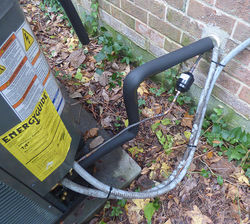 If using un-slit ArmaFlex pipe insulation, you'll need to slit the foam tube lengthwise with a sharp, smooth blade, making sure not to cut all the way through to the other side. After slitting the insulation, apply it over the AC line and use ArmaFlex 520 BLV adhesive to seal the seam. Apply a thin coat of adhesive to each side of the seam using the brush provided with the can of adhesive. Allow the adhesive to dry to the point that it is tacky to the touch. This will take about 2-4 minutes depending on the temperature and humidity. Once the adhesive is tacky, press the seam together with firm pressure.
If using un-slit ArmaFlex pipe insulation, you'll need to slit the foam tube lengthwise with a sharp, smooth blade, making sure not to cut all the way through to the other side. After slitting the insulation, apply it over the AC line and use ArmaFlex 520 BLV adhesive to seal the seam. Apply a thin coat of adhesive to each side of the seam using the brush provided with the can of adhesive. Allow the adhesive to dry to the point that it is tacky to the touch. This will take about 2-4 minutes depending on the temperature and humidity. Once the adhesive is tacky, press the seam together with firm pressure.
- To protect the insulation from future damage, it is a good idea to apply a protective finish like ArmaFlex WB Finish to the insulation. Two coats of WB Finish can easily be brushed on the insulation and will provide years of protection against damage due to UV radiation from the sun.
- Also, don't forget to cover the line inside the house following the same method, in order to prevent pipe sweating.
Helpful technical bulletins:
- ArmaFlex Insulation Thickness Recommendations
- Applying ArmaFlex Insulation Tape
- Exterior Insulation
- ArmaFlex Application Manual
How To Repair A/c Insulation Hose
Source: https://www.armacell.us/blog/post/why-its-important-to-check-insulation-on-residential-ac-units-yearly-and-how-to-replace/
Posted by: gilleygiathe92.blogspot.com

0 Response to "How To Repair A/c Insulation Hose"
Post a Comment